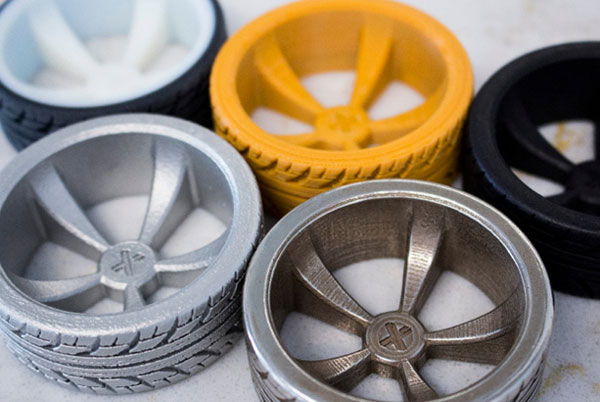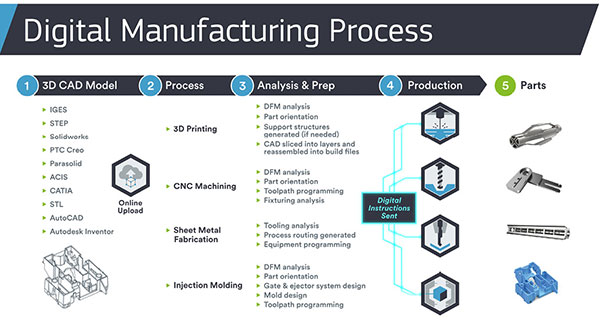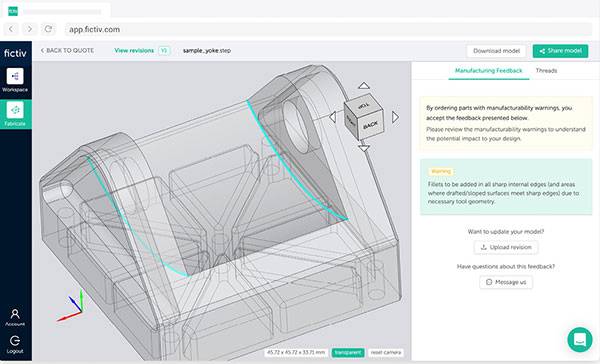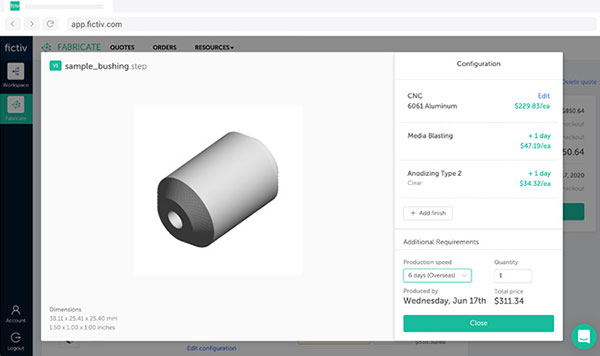MaaS Rewrites Rules for Manufacturing
The business model and the platforms that serve manufacturing-as-a-service are relatively new to the digital landscape, so it’s critical to adapt technologies to meet market demands.

Fig. 1: Manufacturing-as-a-service platforms promise product developers greater flexibility than the traditional manufacturing business model, accommodating increasing demand for customization and providing access to a broad range of production technologies, materials and finishes. Image courtesy of Xometry.
Latest News
April 1, 2021
Ever since Henry Ford installed the first moving assembly line for mass production, the manufacturing business model has operated as a work in progress. The latest stage of this evolutionary process, called manufacturing-as-a-service (MaaS), promises to deliver greater flexibility and efficiency by totally upending traditional supply chain and manufacturing practices, sweeping aside concepts like economies of scale, mass production and specification standardization.
Today, emerging MaaS platforms serve as the primary vehicle for implementing a new manufacturing model. These platforms provide a digital interface that facilitates interaction between service buyers and manufacturers, providing an efficient mechanism for specifying and ordering custom parts and products.
MaaS platforms typically include manufacturing configuration, parts pricing, design for manufacture (DFM) evaluation and order tracking functions.
It’s important, however, to keep in mind that the business model and the platforms that serve MaaS are relatively new to the digital landscape. To understand the emergence of the model and its supporting software platforms, organizations must examine how the traditional manufacturing model meets or fails to meet new market demands, and consider what the technologies must do to satisfy a new generation of consumers.
Change Brings New Demands
Originally, manufacturers produced and sold products in one-time transactions. Using the traditional manufacturing model, plant managers assumed one product would satisfy many customers.
As a result, factories made tens of millions of identical products, using standardized designs and assembly line techniques. Although this approach meets the requirements of economies of scale, it is far from Agile. Traditional manufacturing is slow, and plants must often wait weeks or months for custom components to be delivered.
Unfortunately, market dynamics have changed. Connected devices and machine commoditization plus the growing profile of software have set off a chain reaction that has caused consumers to expect more personalized experiences, as well as products that leverage the almost daily introduction of new technologies. These changes translate into demand for greater customization, with upgrades and new models delivered in months, not years (Fig. 1).
Faced with these challenges, product developers have realized that the traditional manufacturing approach simply cannot meet emerging market demands. A new, more flexible business model is required.
Digitization Brings a New Model
The MaaS model aims to meet the new demands, calling on manufacturers to offer production processes as a service, using scalable and adjustable assembly and manufacturing techniques to complete customized packages based on real-time or current data from clients (Fig. 2).
This approach promises to deliver greater efficiencies by allowing product developers and manufacturers to focus on their core competencies. Using this approach, manufacturers direct all resources to optimize raw material processing and machinery usage, while their customers concentrate on developing and marketing products.
Product-developing companies no longer have to maintain expensive machinery and the skilled labor necessary to operate it. This, in turn, reduces capital expenditures and allows them to choose manufacturing techniques not limited by their own production capabilities.
Market forces, however, are not the only factor driving the introduction of MaaS. Recent technology advances, such as faster internet speeds, cheaper cloud resources and increased protocol-based connectivity provide the infrastructure that makes MaaS possible.
Manufacturing Matchmaking
Combined, all these technologies lay the foundation that enable MaaS platforms to provide a venue where product developers can find a manufacturer with the right set of resources to cost-effectively produce the part or product that they require. This venue takes the form of a technology-driven access point through which customers can search a large database of manufacturers.
“A MaaS platform creates a seamless handshake for buyers and sellers without the need for direct connections or introductions,” says Greg Paulsen, director of application engineering at Xometry. “It usually makes the experience of manufacturing as simple as ordering from sites like Amazon.”
MaaS platforms add value by quickly providing reliable pricing and feedback for purchasing decisions. On the manufacturing side, the supplier benefits from a consistent interface to get work without additional sales or marketing investments.
A MaaS service is, in many ways, a storefront for manufacturing partners, allowing engineers, designers and procurement departments to source parts quickly and enabling manufacturers to have an efficient way to get work that fits them best.
MaaS Building Blocks
It’s important to note, however, that no two MaaS platforms are the same.
“Some systems are out-of-the-box solutions, ready for implementation,” says Maricarmen Senosiain Villalon, direct manufacturing product manager at Stratasys. “Other more robust systems or platforms require customization to meet the needs of the business.”
A typical platform, however, does include some basic subsystems. These include a quoting engine that helps the user to quickly and accurately determine pricing and lead times; a design-for-manufacture feedback engine that allows customers to optimize designs for various processes; and an order-tracking system.
An essential element of these platforms is that they provide a seamless way for customers to securely load their files for a quote request. Ideally, the platform provides mechanisms that automatically parse, configure and provide instant quoting or feedback on the work.
“A true digital MaaS supplier must automate the labor-intensive portions of production,” says Dan Barsness, vice president of product management and e-commerce at Protolabs. “Our software platforms start with quote generation, go on to machine instructions and then through quality systems, [which are] all encapsulated in an e-commerce buying experience. We auto-generate manufacturing quotes based on 3D CAD models and perform a design analysis, calling out any areas of manufacturing to prevent quality issues once production is complete.”

With this type of up-front automation, engineers can produce multiple designs simultaneously and order multiple molds to test and iterate, thereby reducing manufacturing risk and quickly moving to final validation and manufacturing.
Holistic View of the Manufacturing Process
In addition to automated processes, companies that seek the services of a MaaS platform should evaluate other key production aspects. In many cases, this functionality involves providing transparency of the various aspects of the manufacturing process.
For example, it’s important to understand how parts are sourced. Parts may be made through in-house production methods or outsourced to a network of manufacturing partners.
“If manufacturing is outsourced, then you should understand if the network is a large marketplace, where parts are distributed through a job board or if they are matched in a smaller, quality-controlled ecosystem more similar to a digital version of a contract manufacturer,” says Dave Evans, CEO and co-founder of Fictiv.

MaaS platforms should also offer tools that provide insight into the manufacturability of designs (Fig. 3).
“When a company is selecting a MaaS platform to work with, they should look closely at the depth and timing of the DFM feedback,” says Evans. “Some platforms only provide minimal feedback or only provide feedback after the order has been placed, which can result in production delays or nonconformant parts. Ideally, DFM feedback should be comprehensive, [and] provided with pricing information pre-order so that there is upfront clarity around manufacturing expectations.”
Visibility, however, should not stop with the actual production process. MaaS platforms should also provide post-order visibility. One key feature to look for is the availability of on-demand production updates and real-time access to inspection data and photos.
From Order to Delivery
Placing a manufacturing order begins by logging into the MaaS website. Here, the software’s dashboard allows users to perform functions ranging from viewing previous work and quotes to placing and tracking orders.
After the initial process, the buyer uploads the design files, which include 3D CAD files. If the buyer must call out specific requirements, such as tight tolerances, 2D drawings also may be included. Users should be aware that not all platforms accept 2D drawings, so be sure to confirm what file support their products require.

After the design files have been evaluated by the platform’s onboard analytics and the DFM recommendations have been presented, the buyer selects the desired manufacturing process. This can range from 3D printing to computer numerically controlled (CNC) machining and injection molding. During this process, the user also specifies the material and finishing requirements.
For example, this could be anodizing or powder coating. The buyer can also configure each order to add features, quality requirements, even specific certifications needed for the project.
Once the buyer specifies the requirements, a list of manufacturers appears. The buyer selects potential providers who check the order and specifications and then present their quote (Fig. 4). On some MaaS platforms, buyers and manufacturers can also start chats or video calls to clarify aspects of the job.
At this point, the buyer can see how manufacturing location and lead time impact price, review any feedback on the design’s manufacturability and consider recommendations on ways to optimize designs to reduce cost and lead time.
After the buyers make their selections, they finalize the order. The buyer can then track the order’s progress online.
MaaS platforms also simplify the process for reordering parts. Buyers can typically visit an order’s page to review previous DFM feedback and configuration details at any time to easily place another order.
Insights and Flexibility
The value of MaaS platforms lies in the integration of powerful, complementary technologies. For example, much of the insight, accuracy and speed that MaaS platforms bring to pricing and manufacturability feedback can be attributed to the software’s secret ingredient: artificial intelligence (AI) algorithms.
“AI and machine-learning algorithms can derive important costing information through prior work,” says Paulsen. “In theory, the more diverse the work completed, the more accurate the pricing will be. Why not just manually quote? Because of scale. MaaS platforms like Xometry have an enormous supply of parallel manufacturing capacity, with over 5,000 shops globally.”
When the buyer uploads the 3D and 2D design files, the best platforms will analyze the designs to understand the full geometry of the part and determine how much material is required, the number of setups involved, the tools and tool paths called for and the machine runtime needed—everything a manufacturer must know to make the part.
“Digital platforms can identify, for example, if a part is better suited to be milled versus turned, based on geometry,” says Protolabs’ Barsness. “In turn, cost savings can be had, surface finish improved and other manufacturing benefits obtained. Furthermore, digital manufacturing suppliers with multiple processes make it much easier to move from one process to the next.
“If an engineer is looking to take their 3D-printed design into lower-volume production with molding, that engineer can requote the same 3D CAD model for injection molding, get immediate feedback to design for moldability and quickly jump to a different manufacturing process—and more importantly, keep their development on schedule,” Barsness says.
There is, however, more to MaaS platforms than AI-empowered analytics. The software also harnesses visualization to help MaaS customers make the right decisions. Use of AI and visualization technologies becomes particularly important when considering the sheer number of factors that buyers must consider.
“Customers have more choices when using MaaS platforms, which aggregate multiple technologies in one location,” says Paulsen. “A combination of technical resources and integrated site features helps customers when reviewing parts to make better production decisions. Integrated 3D viewers and visual DFM also help show where features may have challenges in a given process.”
Glitches and Blind Spots
Despite the power of MaaS platforms, the systems aren’t without their problems. The reality is that this is a new way to work faster, easier and cheaper, but like any new technology, there are three main things to be aware of:
First, manufacturing jobs calling for special or uncommon features can pose problems, requiring special attention and precise communications.
“If your part needs very specific options, it is better to contact the platform and discuss the issues directly,” says Benoit Schildknecht, marketplace director at Dassault Systèmes. “Also, if you ask for a quote, communicate this clearly to the manufacturers. In some cases, with a specific part, instant quote, manufacturing checks or geometry evaluations can fail to provide the right analysis.”
Second, some platforms have manufacturing limitations.
“Some don’t accept 2D drawings and have limitations around tight tolerance machining, and so they may not be able to deliver on the precision you would expect from a local machine shop,” says Evans. “It’s important to evaluate these capabilities up front in the context of your design complexity requirements.”
Third, quality control issues can also extend beyond the MaaS platform. If parts are outsourced to a network of manufacturing partners, be aware that different platforms have varying quality control systems.
For example, marketplace models optimize for scale, but not necessarily quality control, with every single partner. So, buyers should inquire about the ways in which the MaaS platform sources parts and manages quality systems.
Finding Its Niche
If you were going to describe the evolution of MaaS platforms, “start small, think big” would be a perfect fit. Additive manufacturing, or 3D printing, provided the catalyst for the emergence of MaaS. Early developers of these systems initially focused on 3D printing because some manufacturing companies were reluctant to invest in 3D printing machines, while those that did buy into the technology did not use the equipment full time.
MaaS platforms provide a cost-effective way for companies to use the technology without investing in the infrastructure and equipment. In addition, the approach lets 3D printing houses keep their operations up and running at or near capacity.
“Although many may have limited experience with 3D printing technology, companies in the services industry have been utilizing this tech for decades,” says Senosiain. “At the end of the day, MaaS platforms are driven by customer needs and requirements. The combination of those requirements with the expertise of a manufacturing service provider is vital when pursuing advanced application of 3D printing technology.”
The focus on 3D printing, however, was just the beginning. MaaS advocates realized that 3D printing accounts for only a small share of overall manufacturing. So, the developers of MaaS platforms have extended their model to traditional manufacturing processes, such as CNC machining and injection molding. The inclusion of these processes now accounts for the better share of their revenues.
More Dassault Systemes Coverage

More Protolabs Coverage
More Stratasys Coverage
Subscribe to our FREE magazine, FREE email newsletters or both!
Latest News







